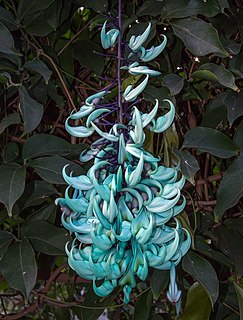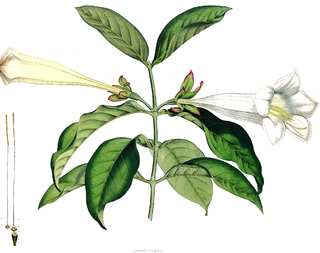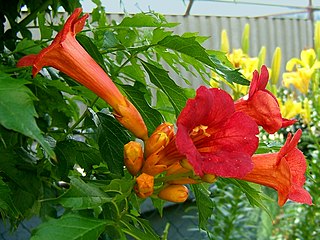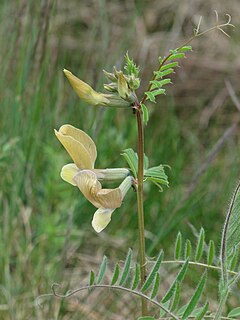
A vine is any plant with a growth habit of trailing or scandent stems, lianas or runners. The word vine can also refer to such stems or runners themselves, for instance, when used in wicker work.

Campsis radicans, the trumpet vine, yellow trumpet vine, or trumpet creeper, is a species of flowering plant in the family Bignoniaceae, native to the eastern United States, and naturalized elsewhere. Growing to 10 m (33 ft), it is a vigorous, deciduous woody vine, notable for its showy trumpet-shaped flowers. It inhabits woodlands and riverbanks, and is also a popular garden subject.

Campsis is a genus of flowering plants in the family Bignoniaceae, native to woodland in China and North America. It consists of two species, both of which are vigorous deciduous perennial climbers, clinging by aerial roots, and producing large trumpet-shaped flowers in the summer. They are reasonably hardy and do well with the support of a wall, preferring full sun.

Magnolia grandiflora, commonly known as the southern magnolia or bull bay, is a tree of the family Magnoliaceae native to the southeastern United States, from Virginia to central Florida, and west to East Texas. Reaching 27.5 m (90 ft) in height, it is a large, striking evergreen tree, with large dark green leaves up to 20 cm long and 12 cm wide, and large, white, fragrant flowers up to 30 cm (12 in) in diameter.

Campsis grandiflora, commonly known as the Chinese trumpet vine, is a fast-growing, deciduous creeper with large, orange, trumpet-shaped flowers in summer. It can grow to a height of 10 meters. A native of East Asia, it is less hardy than its relative Campsis radicans.

Strongylodon macrobotrys, commonly known as jade vine, emerald vine or turquoise jade vine, is a species of leguminous perennial liana endemic to the tropical forests of the Philippines, with stems that can reach up to 18 m in length. Its local name is tayabak. A member of the Fabaceae, it is closely related to beans such as kidney bean and runner bean. Strongylodon macrobotrys is pollinated by bats.

Cryptostegia grandiflora, commonly known as rubber vine, is a woody-perennial vine that is native to south-west Madagascar. It is also a significant weed in northern Australia, sometimes regarded as the worst weed in all of Australia. It has also been introduced to most other tropical and subtropical regions by man, because of its attractive flowers and the fact that its latex contains commercial quality rubber. It is now naturalised in the Caribbean, East Africa, Mauritius, India, Southeast Asia, Indonesia, Latin America, the southern United States, Fiji and New Caledonia. It is very similar to the purple rubber vine, which is also native to Madagascar.

Thunbergia is a genus of flowering plants in the family Acanthaceae, native to tropical regions of Africa, Madagascar and southern Asia. Thunbergia species are vigorous annual or perennial vines and shrubs growing to 2–8 m tall. The generic name honours the Swedish naturalist Carl Peter Thunberg (1743-1828).

Calystegia sepium is a species of flowering plant in the family Convolvulaceae. It has a subcosmopolitan distribution throughout temperate regions of the North and South hemispheres.

Hydrangea arborescens, commonly known as smooth hydrangea, wild hydrangea, sevenbark, or in some cases, sheep flower, is a species of flowering plant in the family Hydrangeaceae. It is a small- to medium-sized, deciduous shrub up to 3 m (10 ft) tall that is native to the eastern United States.

Thunbergia laurifolia, the laurel clockvine or blue trumpet vine, is native to India and Thailand and the Indomalayan realm, the species occurs from Indochina to Malaysia.

Portlandia grandiflora is a species of plant in the family Rubiaceae. Commonly known as the bell flower, this plant is considered native to Jamaica but is also native to Cuba. It is mainly found in limestone montane forests although some occur on karst areas near Jamaica’s coast. It mostly grows on alkaline soils as can be observed by the habitats they are found in. In Jamaica, they flower most frequently in May, June, and August, and fruit during the months of January and December.

Clematis montana, the mountain clematis, also Himalayan clematis or anemone clematis, is a flowering plant in the buttercup family Ranunculaceae. A vigorous deciduous climber, in late spring it is covered with a mass of small blooms for a period of about four weeks. The odorous flowers are white or pink, four-petalled, with prominent yellow anthers. It is native to mountain areas of Asia from Afghanistan to Taiwan.

Beaumontia is a small genus of evergreen woody vines in the milkweed family. It is native to China, the Indian subcontinent, and Southeast Asia.

Cryptostegia is a genus of flowering plants native to tropical Africa and Madagascar. The genus is in the family Apocynaceae.

Campsis × tagliabuana is a mid-19th-century hybrid between Campsis radicans and Campsis grandiflora. It produces trumpet-shaped, orange to red flowers up to 3 in (8 cm) long that appear in loose clusters of 6 to 12. It is a woody, clinging, perennial vine that attaches itself to structures and climbs vigorously with aerial roots like those of ivy. It bears dark-green deciduous leaves, 8–12 in (20–30 cm) long. Its flowers are very attractive to bees, butterflies and birds. Like its parents it is hardy but in cooler temperate regions requires the shelter of a sunny wall to produce its spectacular flowers in abundance.

Thunbergia grandiflora is an evergreen vine in the family Acanthaceae. It is native to China, India, Nepal, Bangladesh, Indochina and Myanmar and widely naturalised elsewhere. Common names include Bengal clockvine, Bengal trumpet, blue skyflower, blue thunbergia, blue trumpetvine, clockvine, skyflower and skyvine.

Cryptostegia madagascariensis is a species of flowering plant in the family Apocynaceae. It is commonly known as purple rubber vine, is a woody-perennial vine that is native to western and northern Madagascar. It has also been introduced to several tropical and subtropical regions by man, including Puerto Rico and the Virgin Islands. It is very similar to the rubber vine, which is also native to Madagascar. In their area of overlap some hybrids have been observed, which are distinguishable by intermediate flower morphology. In the 1930s a hybrid was also developed for horticultural purposes.

Vicia grandiflora, commonly known as large yellow vetch and bigflower vetch, as well as large-flowered vetch, is a common herbaceous plant species in the family Fabaceae, which occurs as a native plant species in Europe and Asia, as well as an introduced vetch species in North America.

Thunbergia battiscombei, also known as the blue glory vine, is a species of flowering plant within the family Acanthaceae. Not to be mistaken with Thunbergia grandiflora, commonly known as the blue trumpet vine.

























